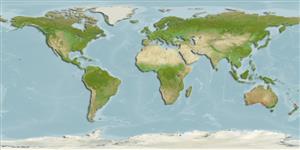分类 / Names
俗名 | 同种异名 | Catalog of Fishes(属, 种) | ITIS | CoL | WoRMS | Cloffa
Teleostei >
Siluriformes (Catfishes) >
Plotosidae (Eeltail catfishes)
Etymology: Cnidoglanis: Greek, knide = nettle + Greek, glanis = a fish that can eat the bait without touching the hook; a cat fish (Ref. 45335).
More on author: Valenciennes.
Environment: milieu / climate zone / depth range / distribution range
生态学
海洋; 半咸淡水 居于水底的; 深度上下限 1 - 30 m (Ref. 6390). 亞熱帶的; 28°S - 37°S
Indo-Pacific: endemic to Australia. Present along both eastern and western Australian coasts, from Kirra in southern Queensland to Jervis Bay in New South Wales, and from Kingston in South Australia to the Houtman Abrolhos in Western Australia. Distributional range extension to the Duck River in Tasmania (Ref. 7300) needs verification.
印度-太平洋: 澳洲的特有種。 存在的沿著東、西澳洲的海岸兩者, 從在昆士蘭南部的 Kirra 到杰維斯海灣在新南威爾斯, 與從在澳洲南部到 Houtman Abrolhos 在西澳大利亞的金斯敦。 在塔斯梅尼亞 (參考文獻 7300) 的分佈區域延長到鴨子河需要確認。
Length at first maturity / 大小 / 重量 / 年龄
Maturity: Lm ?, range 41 - ? cm
Max length : 91.0 cm SL 雄鱼/尚未辨别雌雄; (Ref. 33840); 最大体重: 2.5 kg (Ref. 6390); 最大年龄: 13 年 (Ref. 6390)
简单描述
型态特徵 | 形态测量图
背棘 (总数): 1; 背的软条 (总数): 105-134; 臀棘 0; 臀鳍软条: 95 - 112; 脊椎骨: 77 - 78
An inshore marine species which lives in shallow bays and sandy inlets near river mouths (Ref. 2156). Found most frequently over sand, rocks and weeds in clear to turbid waters. By day, cobblers are most often found in holes and on ledges in banks (Ref. 6390). They are opportunistic feeders, primarily feeding at night. Food consists of bivalve and univalve mollusks, crustaceans (small prawns and amphipods), polychaete worms, algae and organic debris (Ref. 26551). Juveniles eat more crustaceans, often from among drifting macrophytic algae (Ref. 26548). Adults feed mainly on mollusks and polychaetes (Ref. 6390). They are prey to birds such as cormorants and pelicans (Ref. 26548). Presence of sharp spines on the dorsal and pectoral fins can inflict painful wounds (Ref. 2156).
一种近岸的生活在河口附近的浅湾与沙的小水湾中的海洋的种.(参考文献 2156) 在清澈至浑浊的水域中最常发现沙子,岩石与杂草之上了。 白天,皮匠时常最被发现于洞与在浅堆的岩架上.(参考文献 6390) 他们是随机捕食者, 主要地进食在晚上。 食物由双壳贝与单瓣的软件动物,甲壳动物 (小的虾与片脚类动物) ,多毛类的蠕虫, 藻类与有机的残砾组成。 (参考文献 26551) 稚鱼吃更多的甲壳动物, 时常从在漂流大型藻类之中.(参考文献 26548) 成鱼主要捕食软件动物与多毛类动物。 (参考文献 6390) 他们是对鸟例如水老鸦与鹈鹕捕食.(参考文献 26548) 出现在背部上的锐利棘,而且胸鳍能施放令人痛苦的创伤。 (参考文献 2156)
Life cycle and mating behavior
成熟度 | 繁殖 | 产卵场 | 卵 | 孕卵数 | 仔鱼
Males guard the eggs between their pelvic fins for an unknown period in the nest which the male have constructed. The drift weeds found in inshore marine waters, protected inshore marine environments and estuaries act as nursery areas. Cobbler enter these areas during their first year of life and often remain there for long periods (Refs. 26548, 26549).印度-太平洋: 澳洲的特有種。 存在的沿著東、西澳洲的海岸兩者, 從在昆士蘭南部的 Kirra 到杰維斯海灣在新南威爾斯, 與從在澳洲南部到 Houtman Abrolhos 在西澳大利亞的金斯敦。 在塔斯梅尼亞 (參考文獻 7300) 的分佈區域延長到鴨子河需要確認。
Paxton, J.R., D.F. Hoese, G.R. Allen and J.E. Hanley, 1989. Pisces. Petromyzontidae to Carangidae. Zoological Catalogue of Australia, Vol. 7. Australian Government Publishing Service, Canberra, 665 p. (Ref. 7300)
人类利用
渔业: 低经济; 游钓鱼种: 是的
更多信息
参考文献养殖养殖信息品种遗传学Electrophoreses遗传率疾病加工NutrientsMass conversion
合作者照片Stamps, Coins Misc.声音神经毒速度泳型鳃区Otoliths脑重体重比眼睛色素
工具
特别资料
下载 XML
网络资源
Estimates based on models
Preferred temperature (Ref.
123201): 16.8 - 22.3, mean 18.2 °C (based on 192 cells).
Phylogenetic diversity index (Ref.
82804): PD
50 = 1.0000 [Uniqueness, from 0.5 = low to 2.0 = high].
Bayesian length-weight: a=0.00457 (0.00199 - 0.01049), b=3.07 (2.86 - 3.28), in cm total length, based on LWR estimates for this (Sub)family-body shape (Ref.
93245).
营养阶层 (Ref.
69278): 2.8 ±0.32 se; based on food items.
Generation time: 5.5 ( na - na) years. Estimated as median ln(3)/K based on 2
growth studies.
回复力 (Ref.
120179): 中等的, 族群倍增时间最少 1.4 - 4.4年 (tm=2-3; tmax=13; Fec=300).
Fishing Vulnerability (Ref.
59153): Moderate to high vulnerability (54 of 100).
Nutrients (Ref.
124155): Calcium = 35.7 [16.7, 57.7] mg/100g; Iron = 0.342 [0.202, 0.584] mg/100g; Protein = 16.6 [14.7, 18.7] %; Omega3 = 0.351 [0.187, 0.639] g/100g; Selenium = 14.9 [7.3, 31.5] μg/100g; VitaminA = 7.42 [2.66, 21.37] μg/100g; Zinc = 0.641 [0.445, 0.923] mg/100g (wet weight);
